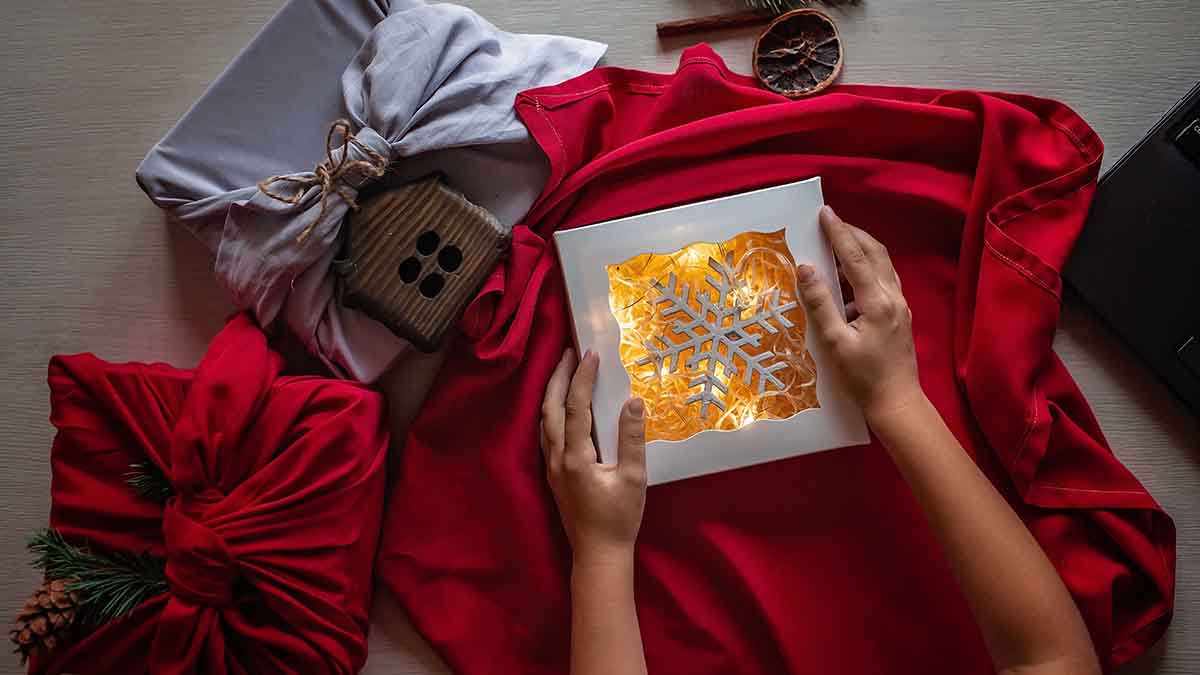Remember as a kid how exciting it was to see wrapped presents just waiting to be torn open? Trying to guess what was in the packages was part of the fun. For me, the only problem was when I finally got to open the presents, I had older family members, particularly one grandmother, watching me and saying, “Don’t rip the paper. We can reuse that next year.” So, I carefully and slowly untied the ribbons and tore the paper as little as possible around the tape as I opened my packages. I learned to be careful because I had to trim the paper of torn edges and tape before folding it up and putting it away for next year’s use.
Now things tend to be a little different. Most people in the U.S. are not concerned about saving wrapping paper for future use. Packages are ripped open quickly and the wrapping paper is discarded. We are more of a single-use, throwaway society now than in years past.
As a result, people in the U.S. use a lot of wrapping paper. About 4.6 million lbs. of wrapping paper is produced in the U.S. each year, Earth911.com estimates. Americans spend approximately $3.2 billion a year on wrapping paper, according to Hallmark research. In other words, a lot of resources and money are being used for wrapping paper which only serves as a temporary covering for gifts. Is this a good idea?
This is an important question to think about. Wrapping paper is made from trees. The mass destruction of trees — deforestation — is happening at a rapid rate. Trees play a critical role in slowing the pace of climate change, as well as preserving diversity of wildlife, and providing products for a growing population of people. Trees absorb the carbon dioxide that people exhale, as well as trap the greenhouse gases that human activities produce. Yet we are sacrificing trees for wrapping paper! For that short-term fun of ripping the paper off, we are jeopardizing the long-term health of our planet and of ourselves.
Some people would say using wrapping paper is not a problem. We just need to recycle it. However, it is not that simple. First, a lot of wrapping paper cannot be recycled. If it contains foil, glitter, artificial texture, sticky gift labels, plastic, or leftover tape or ribbons, it is not recyclable. Most simple nonlaminated paper can be recycled. A simple way to tell if wrapping paper is recyclable is to do the “scrunch test.” The scrunch test involves squeezing the paper into a ball. If it stays in that shape, it is probably recyclable. If it springs back to a flatter form, it is not. Realistically, probably not much wrapping paper gets recycled when a lot of gifts are being unwrapped at a holiday celebration or birthday party. In my experience, there is some trash container nearby in which the paper gets discarded and then it goes to the landfill. Most people don’t know about the scrunch test nor take the time to perform it on each piece of wrapping paper.
Wrapping packages has been a tradition for centuries, particularly in China, Korea, and Japan. In the United States, modern gift wrapping with paper was started by the Hall brothers during the 1917 holiday season and Hallmark has been selling wrapping paper ever since. People seem to enjoy getting wrapped gifts better than gifts without any kind of wrapping or in their original boxes. Perhaps it is the anticipation of the gift or the association of wrapped packages with pleasant past experiences that makes wrapped presents more desirable and valued than unwrapped ones. Is it possible to keep up this tradition of package wrapping, without wrecking our environment? I think it is. But we need to be aware of the problems with wrapping paper and think about ways of wrapping packages which are not as wasteful or damaging.
Alternative gift wraps
There are a lot of ways to conceal a gift without buying expensive, environmentally-damaging paper. Ideally, we can use something we already have as a wrap.
As my grandmother championed, we can reuse wrapping paper until it wears out or gets too small. Or newspaper can be used plain or decorated in various ways, and comics are colorful already. Both are handy for wrapping large packages, particularly for kids.
Wraps made of cloth can be reused indefinitely. Cloth bags are readily available and can be used as bags for gifts. Some people have unused fabric, old sheets and pillowcases, curtains, tablecloths or even old clothes that could be cut up and used to wrap packages. For people who sew, the cloth wraps could be stitched around the edge or lined for a neater look, but that is not necessary. The cloth wrappings could even be decorated with markers to make them more personalized or colorful. Another option is to purchase something to use as a wrap and make the wrap part of the gift. For example, kitchen towels, scarves, sarongs, bandannas, and fancy cloth bags can all serve as a wrap for another gift.
Wrapping a box in cloth
Cut a square of fabric that is about 4 times the size of the longest side of a box you want to wrap. Spread the cloth out flat with the finished side down. Position the box diagonally in the center of the cloth. Fold one corner of the fabric up and over the side of the box and tuck the end under the side of the box. Then wrap the opposite corner over the box. Fold the end under on top of the box. Line up the fold with the edge of the box. Pull the cloth tight around the box. Crease the cloth at the loose ends of cloth, pulling the ends together and tying them. Be sure to hold cloth in the middle of the box to keep the cloth in place while bringing the ends together to tie. Adjust the cloth to smooth it and make the knot look attractive.
This may sound difficult, but it is not. If you want to see how easy it is, just search YouTube for videos about wrapping packages in cloth. Of course, there are a lot of variations and techniques for different shapes of items to wrap. Some even incorporate ribbons, rubber bands, and pins. But practice a basic wrap on a box or book first.
If you look online, you will also find cloth wraps for sale. Many are furoshikis which are traditional Japanese cloth wraps or bojagis which are Korean cloth wraps. Some of the YouTube videos for these show how to make fancy packages or bags and even flowers out of cloth wraps. They look like origami for packages.
With alternative wrappings, you can create beautifully wrapped packages that conceal the gift, while you help our environment. The first occasion that you try alternative wrappings, just try wrapping a few packages in an environmentally friendly way. That will make the wrap part of the surprise. You can have fun doing the “green” wrappings and will find that you don’t have to have glitzy wrapping paper to have valued gifts.
Carol Bergfeld Mills is a Professor Emerita of Goucher College where she taught over 30 years. She can be contacted at [email protected]

Let's keep in touch!
Keep up with the latest OutLook by the Bay information by signing up here. We promise not to waste your time.


